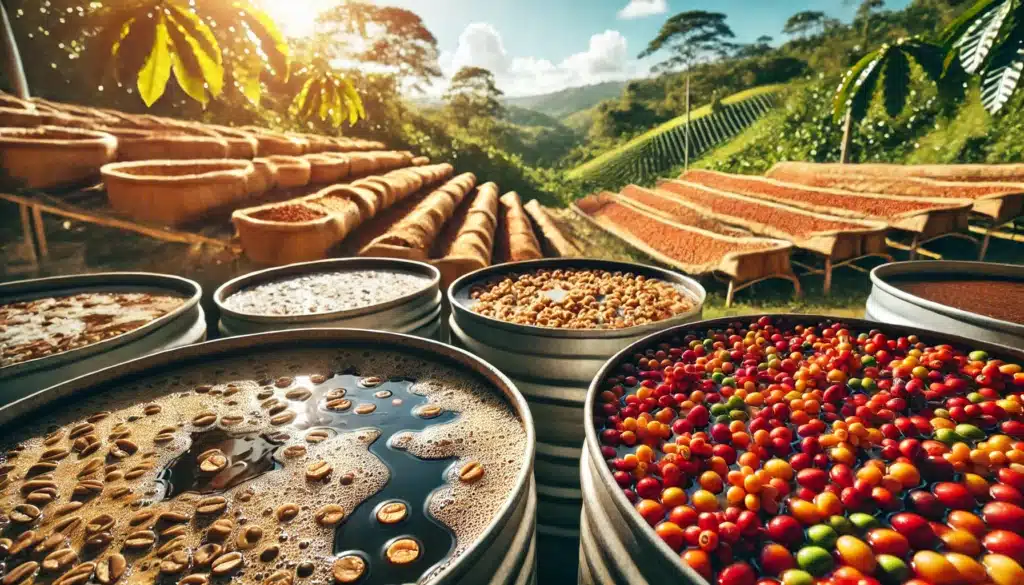Coffee is a complex beverage, capable of revealing delicate floral aromas, bright acidity, rich fruitiness, or deep chocolate undertones — and one of the most important steps in shaping that flavor is fermentation. While often associated with wine or cheese, fermentation is a critical stage in coffee processing that transforms the bean’s chemical structure and sensory profile.
In this article, we’ll explore how fermentation works, the methods used around the world, and how this process can unlock entirely new dimensions of taste in your cup.
1. What Is Coffee Fermentation?
Fermentation in coffee refers to the microbial breakdown of the mucilage, the sticky layer surrounding the bean after the cherry is pulped.
Naturally occurring yeasts and bacteria feed on the sugars and acids in this layer, producing enzymes that help loosen and remove it — and in the process, they alter the bean’s chemistry, impacting aroma, acidity, and mouthfeel.
2. The Traditional Fermentation Process
The most common traditional method is wet fermentation, where pulped beans are placed in tanks or containers filled with water and left to ferment for 12 to 72 hours, depending on climate and altitude.
This method is widely used in:
- Latin America (e.g., Colombia, Guatemala)
- East Africa (e.g., Kenya, Ethiopia)
It typically results in clean, bright, and balanced cups.
3. Dry and Natural Fermentation
In dry or natural processing, the whole coffee cherry is left to ferment on raised beds or patios for several days or weeks under the sun.
Fermentation happens inside the intact fruit, often in more uncontrolled conditions. This can produce:
- Fruity, wine-like flavors
- Increased sweetness and body
- Occasional wild or funky notes
Countries like Ethiopia, Brazil, and Yemen are known for their masterful natural fermentation techniques.
4. Honey and Semi-Washed Methods
Honey processing is a hybrid method where some mucilage is left on the bean while it dries, allowing partial fermentation.
Depending on how much mucilage remains, honey coffees can be categorized as:
- Yellow Honey (light mucilage)
- Red Honey (medium mucilage)
- Black Honey (heavy mucilage)
This process can bring juicy acidity, creamy textures, and sweet complexity — common in Costa Rica and El Salvador.
5. Controlled Fermentation: A New Frontier
In recent years, producers have started using controlled or experimental fermentation, where specific yeasts or bacteria are introduced, and variables like time, temperature, and oxygen are tightly regulated.
These techniques can involve:
- Anaerobic fermentation (no oxygen)
- Carbonic maceration (from winemaking)
- Yeast-inoculated fermentation
The result? Coffees with remarkable clarity, tropical fruit notes, and often unusual, layered profiles.
6. Fermentation and Acidity
Fermentation affects acidity in several ways:
- Encouraging the development of lactic acid (smooth, creamy)
- Preserving malic acid (crisp, apple-like)
- Breaking down sugars into citric acid (bright, citrusy)
The duration and type of fermentation directly influence how pronounced or mellow the acidity will be.
7. Flavor Development and Aromatics
As beans ferment, they absorb byproducts like alcohols, esters, and aldehydes, which contribute to:
- Fruity or floral aromas
- Enhanced sweetness
- Complex flavor layering
Skilled fermentation can bring out notes of pineapple, blueberry, jasmine, or spice, depending on the origin and method.
8. Risks of Poor Fermentation
Fermentation is delicate. If mismanaged, it can lead to:
- Over-fermentation, resulting in sour, vinegary, or rotten notes
- Mold contamination, especially in humid environments
- Inconsistent flavors in large batches
This is why some farmers prefer simpler methods — but those who master fermentation can create exceptional, high-scoring coffees.
9. Fermentation and Specialty Coffee
Fermentation has become a playground for innovation in specialty coffee.
Roasters now seek out fermentation-forward lots with unique cup profiles, and competitions like the Cup of Excellence often feature experimental processing.
Some of the most sought-after coffees today — like anaerobic Colombian micro-lots or carbonic macerated Panamanian Geishas — owe their magic to fermentation.
10. How to Taste Fermentation in Your Cup
To experience the influence of fermentation, try:
- Comparing washed vs. natural coffees from the same origin
- Exploring anaerobic or honey-processed coffees from reputable roasters
- Noting flavors like overripe fruit, booziness, or floral high notes
Fermentation doesn’t just change coffee — it creates a conversation between the producer, the bean, and your palate.
Final Thoughts: The Microbial Alchemy of Coffee
Fermentation is one of coffee’s greatest transformations — invisible to the eye, yet essential to the flavor we love.
Whether you’re sipping a bright Kenyan washed or a funky Ethiopian natural, you’re tasting the result of microbial artistry and generations of craft. As producers continue to explore new techniques, fermentation will remain one of the most exciting frontiers in coffee.







